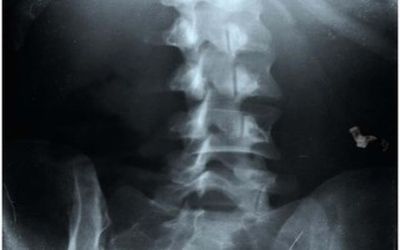No Sponge Left Behind
Using the same technology found in clothing tags used in retail store tracking systems, a study from the University of North Carolina at Chapel Hill shows that surgical sponges with implanted radio frequency (RF) tags may be an effective adjunct to manual counting and X-ray detection in preventing sponges from being left behind in patients following a surgical procedure.


A sponge left inside a patient is visible in the lower right quadrant of this X-ray image. Image courtesy of Christopher C. Rupp, MD.Â
Using the same technology found in clothing tags used in retail store tracking systems, a study from the University of North Carolina at Chapel Hill shows that surgical sponges with implanted radio frequency (RF) tags may be an effective adjunct to manual counting and X-ray detection in preventing sponges from being left behind in patients following a surgical procedure.
UNC surgeons will report the preliminary results of the study on Oct. 5 during a poster session at the 2010 Annual Clinical Congress of the American College of Surgeons in Washington, D.C.
The reported incidence of a sponge or another foreign body, such as a surgical instrument, being left behind after operations has varied widely over the years. Previously published reports have estimated ranges of one in 1,000 operations to 1 in 18,000.
"Our preliminary data agrees with the previously reported incidence of retained surgical sponges," said lead investigator UNC gastrointestinal surgeon Christopher C. Rupp, MD. The researchers used a radio-frequency (RF) detection device in 1,600 operations, and found a sponge in one operation in which manual counting of the sponges was correct.
Sponges used to absorb fluids and improve access to organs during surgical procedures are much different than household sponges. Surgical sponges are mostly made of cotton, and come in sizes of 12-by-12 inches or as small as 4-by-4 inches. These sponges can become difficult to see during an operation because they can mold into different shapes and take on the same color of the fluids being absorbed. Furthermore, the sponges can migrate to other areas of the operative field, and they can be difficult to feel with surgical gloves.
Surgeons use various methods to track sponges during operations. The most common is manual sponge counts by a nurse, but more sophisticated methods include the radio-frequency tagged sponges used in the UNC study, X-ray of the abdomen and bar-coded sponges. The UNC investigators did not include bar-coding systems in their study. Human error involved with manual counting and X-ray interpretation were the impetus that resulted in the studies inception, Rupp reported.
The RF-tagged system in the UNC study has the same technology found in the clothing tags used in retail store tracking systems and in microchips embedded in pets. During surgery, a nurse passes a wand over the patients body to pick up readings from the RF tags. Newer versions have detection hardware built into the mat the patient lies on. "RF detection is not going to replace counting in the operating room, but it can be used as an adjunct because, from what were seeing in the preliminary data, it adds a lot to the safety of the procedure," Rupp said.
"Any foreign body present long enough has a risk of causing infection," he explained, noting there are patients in whom sponges have eroded into other organs, mainly the intestines. "People can come back with chronic pain issues after an operation that also leads to detection of a retained surgical sponge," which may require being hospitalized for additional surgery.
Other UNC co-authors were surgical oncologist Hong J. Kim, MD, and adjunct professor of surgery Mary J. Kagarise, RN, MSPH.
Uncovering a Hidden Risk: Alcohol Use Disorder Significantly Increases C difficile Infection Rates
April 10th 2025A groundbreaking study reveals a strong connection between alcohol use disorder and increased risk for Clostridioides difficile infection, challenging traditional assumptions and calling for enhanced infection prevention protocols.
Bridging the Gap: Operating Room and Central Processing Unite to Improve Surgical Efficiency
April 8th 2025Communication breakdowns between the operating room and central processing led to delays and frustration—until collaboration, cross-training, and shared goals turned metrics around and strengthened teamwork.